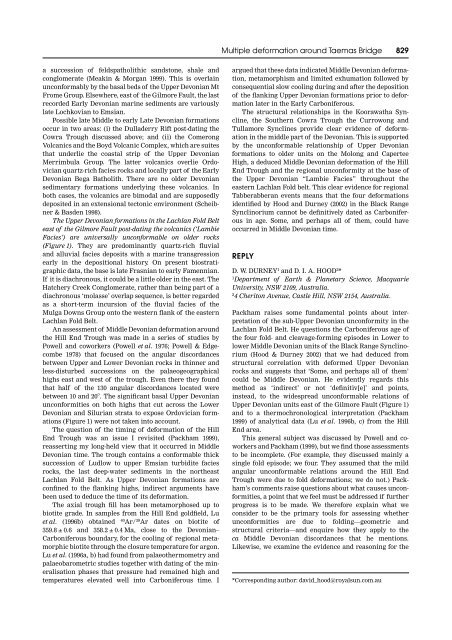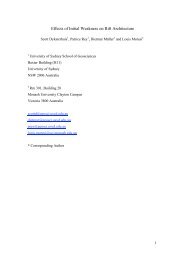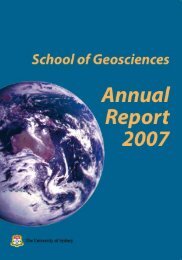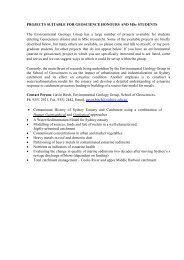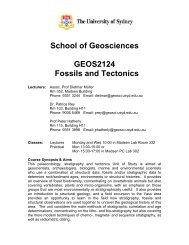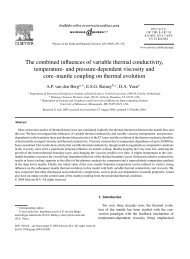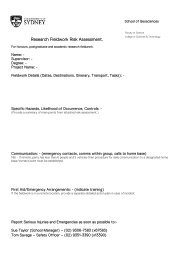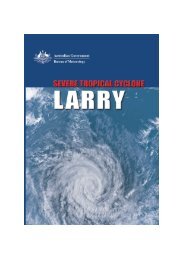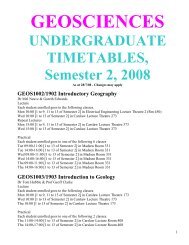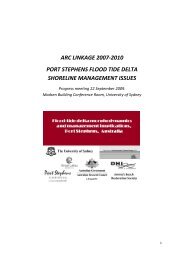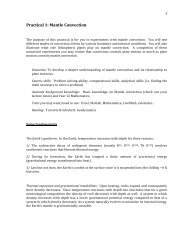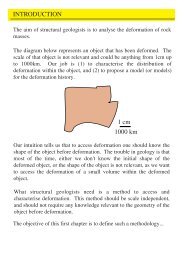View - School of Geosciences
View - School of Geosciences
View - School of Geosciences
Create successful ePaper yourself
Turn your PDF publications into a flip-book with our unique Google optimized e-Paper software.
Multiple deformation around Taemas Bridge 829<br />
a succession <strong>of</strong> feldspatholithic sandstone, shale and<br />
conglomerate (Meakin & Morgan 1999). This is overlain<br />
unconformably by the basal beds <strong>of</strong> the Upper Devonian Mt<br />
Frome Group. Elsewhere, east <strong>of</strong> the Gilmore Fault, the last<br />
recorded Early Devonian marine sediments are variously<br />
late Lochkovian to Emsian.<br />
Possible late Middle to early Late Devonian formations<br />
occur in two areas: (i) the Dulladerry Rift post-dating the<br />
Cowra Trough discussed above; and (ii) the Comerong<br />
Volcanics and the Boyd Volcanic Complex, which are suites<br />
that underlie the coastal strip <strong>of</strong> the Upper Devonian<br />
Merrimbula Group. The latter volcanics overlie Ordovician<br />
quartz-rich facies rocks and locally part <strong>of</strong> the Early<br />
Devonian Bega Batholith. There are no older Devonian<br />
sedimentary formations underlying these volcanics. In<br />
both cases, the volcanics are bimodal and are supposedly<br />
deposited in an extensional tectonic environment (Scheibner<br />
& Basden 1998).<br />
The Upper Devonian formations in the Lachlan Fold Belt<br />
east <strong>of</strong> the Gilmore Fault post-dating the volcanics (‘Lambie<br />
Facies’) are universally unconformable on older rocks<br />
(Figure 1). They are predominantly quartz-rich fluvial<br />
and alluvial facies deposits with a marine transgression<br />
early in the depositional history. On present biostratigraphic<br />
data, the base is late Frasnian to early Famennian.<br />
If it is diachronous, it could be a little older in the east. The<br />
Hatchery Creek Conglomerate, rather than being part <strong>of</strong> a<br />
diachronous ‘molasse’ overlap sequence, is better regarded<br />
as a short-term incursion <strong>of</strong> the fluvial facies <strong>of</strong> the<br />
Mulga Downs Group onto the western flank <strong>of</strong> the eastern<br />
Lachlan Fold Belt.<br />
An assessment <strong>of</strong> Middle Devonian deformation around<br />
the Hill End Trough was made in a series <strong>of</strong> studies by<br />
Powell and coworkers (Powell et al. 1976; Powell & Edgecombe<br />
1978) that focused on the angular discordances<br />
between Upper and Lower Devonian rocks in thinner and<br />
less-disturbed successions on the palaeogeographical<br />
highs east and west <strong>of</strong> the trough. Even there they found<br />
that half <strong>of</strong> the 130 angular discordances located were<br />
between 10 and 20. The significant basal Upper Devonian<br />
unconformities on both highs that cut across the Lower<br />
Devonian and Silurian strata to expose Ordovician formations<br />
(Figure 1) were not taken into account.<br />
The question <strong>of</strong> the timing <strong>of</strong> deformation <strong>of</strong> the Hill<br />
End Trough was an issue I revisited (Packham 1999),<br />
reasserting my long-held view that it occurred in Middle<br />
Devonian time. The trough contains a conformable thick<br />
succession <strong>of</strong> Ludlow to upper Emsian turbidite facies<br />
rocks, the last deep-water sediments in the northeast<br />
Lachlan Fold Belt. As Upper Devonian formations are<br />
confined to the flanking highs, indirect arguments have<br />
been used to deduce the time <strong>of</strong> its deformation.<br />
The axial trough fill has been metamorphosed up to<br />
biotite grade. In samples from the Hill End goldfield, Lu<br />
et al. (1996b) obtained<br />
40<br />
Ar/ 39 Ar dates on biotite <strong>of</strong><br />
359.8 ± 0.6 and 358.2 ± 0.4 Ma, close to the Devonian–<br />
Carboniferous boundary, for the cooling <strong>of</strong> regional metamorphic<br />
biotite through the closure temperature for argon.<br />
Lu et al. (1996a, b) had found from palaeothermometry and<br />
palaeobarometric studies together with dating <strong>of</strong> the mineralisation<br />
phases that pressure had remained high and<br />
temperatures elevated well into Carboniferous time. I<br />
argued that these data indicated Middle Devonian deformation,<br />
metamorphism and limited exhumation followed by<br />
consequential slow cooling during and after the deposition<br />
<strong>of</strong> the flanking Upper Devonian formations prior to deformation<br />
later in the Early Carboniferous.<br />
The structural relationships in the Koorawatha Syncline,<br />
the Southern Cowra Trough the Currowong and<br />
Tullamore Synclines provide clear evidence <strong>of</strong> deformation<br />
in the middle part <strong>of</strong> the Devonian. This is supported<br />
by the unconformable relationship <strong>of</strong> Upper Devonian<br />
formations to older units on the Molong and Capertee<br />
High, a deduced Middle Devonian deformation <strong>of</strong> the Hill<br />
End Trough and the regional unconformity at the base <strong>of</strong><br />
the Upper Devonian “Lambie Facies” throughout the<br />
eastern Lachlan Fold belt. This clear evidence for regional<br />
Tabberabberan events means that the four deformations<br />
identified by Hood and Durney (2002) in the Black Range<br />
Synclinorium cannot be definitively dated as Carboniferous<br />
in age. Some, and perhaps all <strong>of</strong> them, could have<br />
occurred in Middle Devonian time.<br />
REPLY<br />
D. W. DURNEY 1 and D. I. A. HOOD 2 *<br />
1<br />
Department <strong>of</strong> Earth & Planetary Science, Macquarie<br />
University, NSW 2109, Australia.<br />
2<br />
4 Cheriton Avenue, Castle Hill, NSW 2154, Australia.<br />
Packham raises some fundamental points about interpretation<br />
<strong>of</strong> the sub-Upper Devonian unconformity in the<br />
Lachlan Fold Belt. He questions the Carboniferous age <strong>of</strong><br />
the four fold- and cleavage-forming episodes in Lower to<br />
lower Middle Devonian units <strong>of</strong> the Black Range Synclinorium<br />
(Hood & Durney 2002) that we had deduced from<br />
structural correlation with deformed Upper Devonian<br />
rocks and suggests that ‘Some, and perhaps all <strong>of</strong> them’<br />
could be Middle Devonian. He evidently regards this<br />
method as ‘indirect’ or not ‘definitiv[e]’ and points,<br />
instead, to the widespread unconformable relations <strong>of</strong><br />
Upper Devonian units east <strong>of</strong> the Gilmore Fault (Figure 1)<br />
and to a thermochronological interpretation (Packham<br />
1999) <strong>of</strong> analytical data (Lu et al. 1996b, c) from the Hill<br />
End area.<br />
This general subject was discussed by Powell and coworkers<br />
and Packham (1999), but we find those assessments<br />
to be incomplete. (For example, they discussed mainly a<br />
single fold episode; we four. They assumed that the mild<br />
angular unconformable relations around the Hill End<br />
Trough were due to fold deformations; we do not.) Packham’s<br />
comments raise questions about what causes unconformities,<br />
a point that we feel must be addressed if further<br />
progress is to be made. We therefore explain what we<br />
consider to be the primary tools for assessing whether<br />
unconformities are due to folding—geometric and<br />
structural criteria—and enquire how they apply to the<br />
ca Middle Devonian discordances that he mentions.<br />
Likewise, we examine the evidence and reasoning for the<br />
*Corresponding author: david_hood@royalsun.com.au


